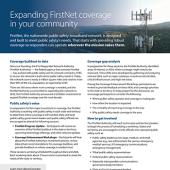What is priority and preemption?
FirstNet, the nationwide public safety broadband network, is specifically designed to meet public safety’s critical communications needs. Two of the key public safety features of FirstNet are priority and preemption.
Priority and preemption allow first responders to communicate with minimal or no interruption, essentially giving their data ‘lights and sirens’ to cut through network congestion. With FirstNet, public safety’s traffic is separated from non-public safety traffic via the FirstNet Core and is always prioritized over commercial traffic. This feature is automatic and always on, 24/7, with no action necessary from FirstNet users.
Defining priority and preemption
Public safety devices gain access to the network first. Public safety is at the front of the line.
Public safety devices are treated as the most important on the network. Network resources cannot be taken from public safety. In severe circumstances, commercial users will be moved to different frequencies or may be momentarily disconnected.
Priority and preemption help first responders in both extreme and everyday circumstances. During an emergency, networks can become congested with everyone in the area trying to learn more or talk to each other. In Ohio, responders from the City of Canton and Stark County experienced the value of FirstNet first hand when they needed to stay in contact as they evacuated over 30,000 concertgoers from the Tom Benson Hall of Fame Stadium during a severe thunderstorm. Nervous attendees started connecting to commercial networks, but, despite the increase, responders seamlessly communicated over FirstNet and got everyone to safety. This was FirstNet’s priority access feature in action.
Law enforcement officers from the Derry Police Department in New Hampshire found that when the evening shift of officers came to sign on to the broadband devices in their cruisers, there wasn’t enough bandwidth. The cause? Teenagers. When the largest high school in the area let out in the afternoon, 3,300 students and their teachers would all jump on the commercial cellular network. Officers sometimes could not connect to the network until hours later. Since the department switched to FirstNet, they have had connectivity all of the time because they are given priority and preemption.
Testing priority and preemption in the FirstNet lab
The First Responder Network Authority (FirstNet Authority) checks that priority and preemption on FirstNet work like they should. The FirstNet Innovation and Test Lab is a state-of-the-art laboratory in which the FirstNet Authority verifies and validates public safety functionality and features unique to the FirstNet network, including priority and preemption. The lab’s specialized tools allow it to simulate heavy traffic on the network.
While impossible to put thousands of devices in a single lab to make calls, connections, or transfer files all at exactly the same time, the FirstNet Lab has specialized equipment to simulate a scenario where the public or many first responders are trying to access the network at the same time. The load test tools in the lab are able to emulate 6,000 smartphones with a mixed of different type of traffic such as messaging, voice calls, and video. Researchers conduct specific tests to make sure that a responder using one device gets the experience as designed and expected. With these simulations, researchers can see how first responder assets continue to get access, even on a saturated network. To learn more about the FirstNet Experience and priority and preemption features, watch behind the scenes videos from the FirstNet Lab:




















